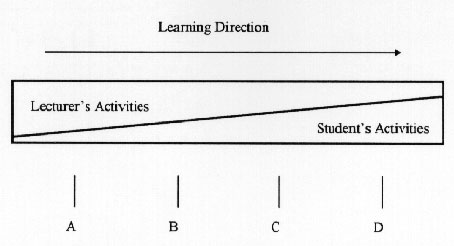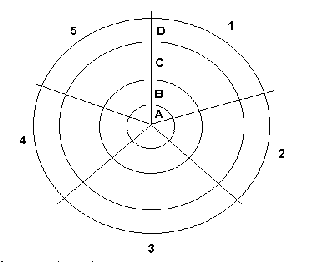
PETRA MODEL: AN ALTERNATIVE FOR ENGINEERING EDUCATION
ABSTRACT
This work describes an academic implementation and adaptation approach of the PETRA(ProjEct and TRAsference) model applied at the Escola Federal de Engenharia de Itajubá - EFEI. This model was developed by Siemens AG in 1985. It is shown the model's basic concepts and its first results at EFEI.
The professional formation of the PETRA model has been created to cease the companies dissatisfaction regarding the newly graduated professionals. This dissatisfaction is due to the technical capacity and, mainly, the many personal qualities necessary in any professional. The PETRA techniques promotes the development of 39 personal qualities wanted by the companies.
INTRODUCTION
It is unquestionable that problems with professional formation occurs, with more or less intensity, everywhere in the world. For instance, in Germany, the difficulties that Brazil starts to experience related to this subject, had been already detected around middle of the seventies, that means, the profile of the egresses from the educational system were not achieving the needs of the industries [1]. At that time, it was desirable the professional should show, apart from technical abilities, some personal attributes that makes him adaptable to quick changes in the environment.
From the experimental application of professional formation models, the mother company Siemens AG, created the PETRA model (ProjEct and TRAnsference) that, after the approval of the German Education and Science Board, it was implemented in its industrial complex beginning February 1985.
The PETRA model, created, validated and systematized by Siemens AG, came to Brazil in 1992 by SENAI-SP (National Service of Industrial Learning), is being adapted to the Brazilian needs, like qualifying workers in a moment characterized by the international competition defined as internationalization of the market and the acceleration of the technological changes. Through a cooperative agreement with SENAI, the Escola Federal de Engenharia de Itajubá EFEI got in touch with this model.
From this knowledge acquired and the observation of positive experiences of the PETRA implementation in some other places via SENAI, it was designed a project denominated "Oriented Formation of Engineers to the Project and Technology Transference", with the aim of apply the PETRA model at EFEI, adapted to the engineering courses offered in this institution. This project is supported by the Program of the Development of Engineering Courses - PRODENGE, which is an alliance between governmental boards.
OVERVIEW OF THE PETRA MODEL
The PETRA model was created to solve the enterprises dissatisfaction with the egresses profile of the professional formation system, not only with technical abilities but mainly with the several vital personal qualities to any professional. In the mnemonic PETRA two words are fundamentals: Project and Transference. So, the promotion of the personal attributes in the students is achieved during the development of a technical project. In this context, project is understood as one activity that demands from the students a technical performance with different levels of complexity that sensitizes and promotes on them several personal qualities. Transference means the application of acquired knowledge, abilities and attitudes in new or modified situations [1]. It is important to emphasize that this model is applied in any subject or occupation.
In the PETRA model are applied techniques to promote 39 personal qualities in the student that, according to researches, are desirable by the enterprises in general [2]. These qualities are classified in five sets denominated key qualifications [3]: Organization and Execution of Work, Interpersonal Communication, Self-Development, Autonomy and Responsibility and Withstand Pressure. Table 1 shows this key qualifications and its corresponding personal qualities.
Aiming to unify the understanding of the concepts, each one of the personal qualities, showed on Table 1, are defined and explained to the students.
It is lecturer's duty, during the development of the project, applying several techniques to promote in the students either by himself or as a member of a group, each one of the personal qualities mentioned previously. Among several techniques it is worth to present the following:
| Organization and Execution of Work | Interpersonal | Self-Development | Autonomy and Responsibility | Withstand Pressure |
| Self-sufficiency
Self-valuation capacity Planning Capacity Coordination Determination Precision Rationalization Zeal |
Cooperation
Empathy Impartiality Integration Leadership Dialogue maintenance Argumentation Objectivity Participation Receptivity |
Research capacity
Problems resolution Capacity Transference Capacity Oral and writing expression Generalization Reading and text interpretation Reading and interpretation of draws and circuits Learning promptitude Utilization of learning techniques |
Quality
Conscience Security Conscience Discipline Envolvement Initiative Judgment Self-limitation recognition |
Attention
Concentration Capacity Physical posture compensation Flexibility Perseverance Listen promptitude |
Table 1 -Key qualification and respective personal qualities.
The lecturer will receive several orientations, like:
Generally, the student's performance profile in the PETRA, is a set of technical performances. The outlet profile assesses the technical abilities and personal qualities. In this way, four levels of key-qualifications' performance are defined: Reproduction, Reorganization, Transfer and Problems Solving, utilized by the teacher to evaluate the students development. The students with the lecturer, pass gradually and progressively for each one of these levels, where both have defined rules, described in Table 2.
| At level of: | The Student | And the Teacher |
| Reproduction (A) | imitate, copy, repeat. | prove, control, reinforce. |
| Reorganization (B) | comprehend, incorporate, fix. | prove, supervise, reinforce. |
| Transference (C) | apply, adapt, transform. | advise. |
| Problems Resolution (D) | discover, generate, create. | observe |
Table 2 - Levels of key-qualifications performance
It is important to mention, that at beginning of the PETRA, the lecturer's activities prevail on the students ones, that means, the activity is dominated by the lecturer. As the student advances in levels of performance, his/her activities pass to prevail on the lecturer's ones. When the student achieves the problem solving level, the lecturer has the rules of supervising, advising or, simply, observing. The Figure 1, shows what was just described.

The wished performance profile, indicates the level in each one of the key-qualifications has to be developed. It represents the learning aims to be achieved by the students and are used as database to decision to be taken by the lecturer in his planing. The Figure 2 illustrates a diagram, where the student's performance profile is delineated.

One of the professional formation aims from the PETRA model is to develop the student's independence or autonomy [4]. There are several activities planned to be done by the students themselves, like: studying, researching, problems solving, teamworking, learning transfer, etc.
As already mentioned on section I, after taking contact with the PETRA model by SENAI-MG, a project was developed to introduce that concept in EFEI. The purpose was verifying the results and disseminating the idea to other areas in the case the results were satisfactory. An approved project at the PRODENGE/REENGE program is been applied, in a first stage with undergraduates developing skills to manage their own scientific assignments and projects. The acquired experience will be used in a second stage to train EFEI's professors by the SENAI-SP teaching staff.
This training is specially important for the professor to promote in the students so desired autonomy. As an example, is asked to the students to make themselves given research. Normally, the instructor adopts two procedures. First, he simply asks the students to accomplish the task, making them, in most of the cases , frustrated to not be able to solve the problem. In a second approach, the professor makes himself all the job and gives a class about the theme, eliminating the student's opportunity of learning to act by themselves. In both cases, the students hardly will learn the intended ability, becoming more dependents. When the instructor is prepared to deal with the that situation, he initially presents a guideline and orients the students in the sense to reproduce it and reorganize it. Later, he projects new or modified situations, in order the students to transfer the knowledge and solve all and any problem involving seeking of information with more autonomy.
Kuan Tzu, a Chinese philosopher that lived in III B. C., was already concerning about humanity education for the autonomy [1], Very famous are his phrases:
"If you wish planting for one year, sow the grain! If you wish planting for one decade, plant a tree!. But, if you wish planting for the whole life, then educate the humanity!"
"If you give the man a fish, he will feed just once. But, if you teach him how to fish, he will feed for the whole life!"
At present, is being developed at EFEI the following scientific undergraduate works: "Elaboração de um Tutorial do Software de Simulação Design Center versão 6.0", Aplicações Industriais de Dispositivos Semicondutores" and "Kit Didático para Controle PWM Microprocessado para Inversores VSI/Monofásicos", all of them are being oriented under the light of the PETRA model.
Effectively, is possible to note in the students the promotion of so many personal qualities during the activities of this nature. It is possible to verify the differences when the works are oriented with the PETRA model in comparison with the cases where the method is not applied. The students themselves, when evaluating the method, conclude about the importance of this type of background that, allied to the technical formation, will help them to succeed.
The adjustment and fulfillment of the PETRA model in the EFEI's courses have as objective the creation of an environment and job's conditions very close to those an engineer will find in the industry, however in academic circumstances. The basic strategy is "doing while learning" to absorb better the transmitted knowledge and to make the students less vulnerable when he enters to the labor market as a new engineer.
So far, the analysis of the results applying the PETRA model in the professional formation at EFEI shows its efficiency and its ability to achieve the pursued objectives. Despite being initially applied only to undergraduates, developing works in their basic formation, the model can also be applied in teaching, thesis and dissertation advising and other academic matters in the engineering courses.
In order to carry out this method in professional formation institutions, three conditions must be satisfied: The students must have a good grasp in the main activities (i.e. electronics, mechanics, etc.) , the instructor must be very familiarized with model and the curriculum has to envision an appropriated schedule to develop typical industrial projects.
To FINEP, CNPq, CAPES and SESU, official sponsors of the PRODENGE/REENGE program, integrating part of the "Formação Orientada do Engenheiro para o Projeto e Tranferência de Tecnologia" project.
To Mr. Paulo César Rosa for your contribution in translating the originals in Portuguese.
[1] FRANCESCHINI, H.A., GONÇALVES, M.A., CRUZ, S.B. Formação orientada para o projeto e a transferência Manual do Instrutor. 3. ed. São Paulo: SENAI-SP, 1994.
[2] ASSIS, M. de. A expectativa da indústria nacional quanto à formação de mão-de -obra pelas instituições de educação. São Paulo: SENAI-SP, 1991.
[3] REETZ, L. O conceito de qualificações-chave na formação profissional. Trad. de Hélio Antônio Franceschini. In: Zeitschrift für Berufs- und Wirtschaftspädagogik., 1989.
[4] KLEIN, U. et alii. PETRA Projekt- und transferorientierte ausbildug grudlagen, beispiele, planungs- und arbeitsunterlagen. Siemens AG, München, 1990.